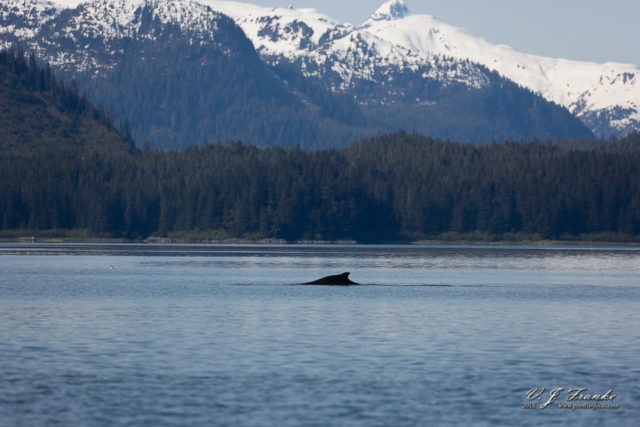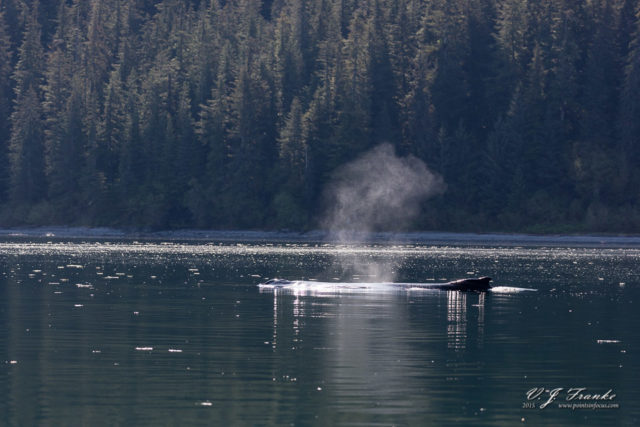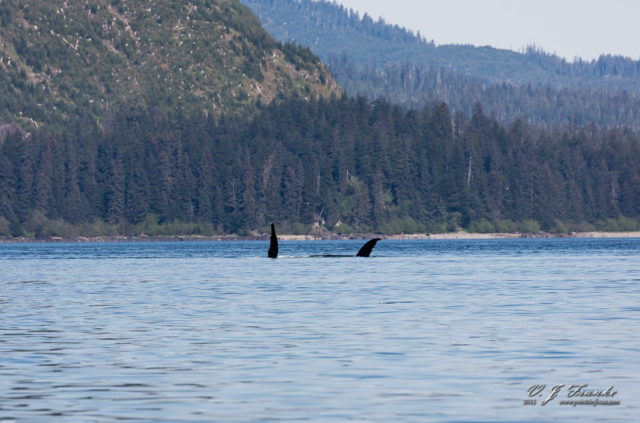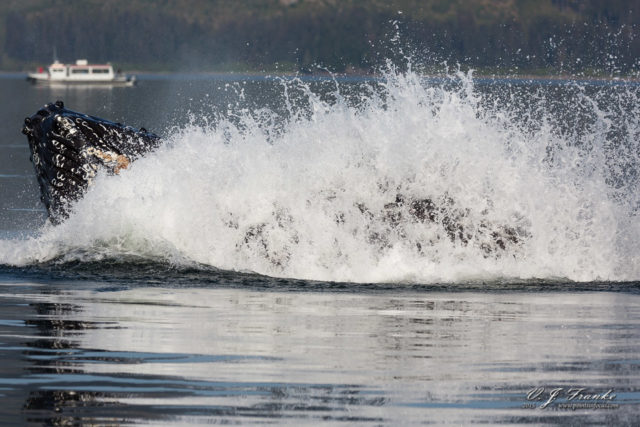Whale Watching off the Icy Straits
Back in May I went on a cruise in Alaska. While this trip wasn’t purely for photography, I wasn’t about to leave my camera at home. This is the 6th installment of this series covering a number of photographic opportunities and how I felt they could be best exploited. The previous parts include shooting from a floatplane on Big Goat Lake in Misty Fjords National Monument, a glacier walkabout on Mendenhall Glacier, the photographic opportunities on Mount Roberts nature trails, riding and shooting from the White Pass and Yukon Route, photographing the waterfalls along the Lynn Canal, and photographing in Glacier Bay National Park. This time I’ll be talking about whale watching and photography from a small boat in the waters around Icy Strait Point and Hoonah, Alaska.
Icy Strait Point and Hoonah, Alaska
Icy Strait point, and the nearby town of Hoonah, is not a destination for most Alaskan cruises. Located off the Icy Straits in Port Frederick, an inlet more than a port as many would expect, this is as close to untouched Alaska as I think you can reasonably get on a cruise. Even Port Frederic as a “port” is tenuous at best. Cruise ships, of which I believe only one can be in “port” at a time, do not dock here. Instead they anchor in the inlet off Cannery Point. Passengers are then tendered ashore.
On shore, the old fish cannery has been converted into a visitors center, native’s craft shop, and eatery. It’s also the jumping off point for the world’s longest zip line, and all the other excursions that are available out of Icy Strait Point and Hoonah.
Broadly speaking, there are three things to do in Hoonah as far as excursions go. You can ride the zip-line, experience some traditional Alaskan performances and buy some traditional crafts, or go view wildlife (mostly bears and whales). If you’re looking for another instance of the cliché diamond and gold shops that litter the docks in every other port of call, you’re not going to find that here, and that’s just fine by me.
Since I’m writing about whale watching in this article it should be pretty obvious what I did. I would have liked to have gone on a bear watching excursion as well, however, at the time I was there, May, and with the time frame we were in port, that wasn’t really practical.
Whale Watching
Whales can make for interesting subject matter if the conditions, namely their behavior, are right. However, as interesting as they can be, more often than not they’re little more than a fin or back breaking the water. Moreover, they can also be exceptionally challenging subjects.
Being aquatic mammals, whales don’t present the kinds of photographic opportunities that terrestrial and avian animals present. The vast majority of photographic appertains will be spouts and backs, and honestly, these get old quickly. More dramatic behaviors like breaches and fin slaps occur far less frequently.
Like most wildlife, timing, patience, and knowledge of the species and environment are invaluable. Obviously only some of these are under your control, and if you’re working from a “whale” watching tour, especially if you’re on a cruise excursion, you’ll have even less control than on chartered boat of your own.

Knowledge
Of the variables that you can control, at least as a visitor, knowledge is the one you have the most control over. Moreover, I would further argue that knowledge of the behaviors of the species you’re photographing gives you the biggest advantage in anticipating when to be ready for the best possible shots.
Don’t get me wrong, you’re not going to go into an inlet for the first time and know more than your local captain about where to see whales and what to expect. The kind of knowledge that’s most useful for us as photographers is general information about the species you’re photographing, and their behaviors.
There are a number of species of whale, propose and dolphin that can be seen in the south-eastern waters during Alaska’s summer season. Most whale watching tours focus on the two most common of these, Humpback Whales (Megaptera novaeangliae) and Orca or Killer Whales (Orcinus orca)[1], so these are the two species I’m going to focus on in this article. However, while sailing in Alaskan waters, I spotted 3 species of large whales, and 2 species of porpoise.
I’ve included some notes about the two most popular species (Humpbacks and Orca) at the end of this section.

The second bit of information I found useful, namely by not knowing it, is some information about the bathymetry, or depth and contour of the ocean floor. Now I will stress, this is not something you need to memorize in great detail, and you can rely heavily on the local knowledge of your boat captain. I just asked our captain about the lay of the land so to speak, namely how deep the water was and if there were any shallow areas or shoals.
Large whales, like humpbacks, simply can’t swim where there’s only a couple of feet of water, and they’re going to be more restricted when the water is only say 20 feet deep than when it’s 200 feet deep. So knowing that the water is extremely shallow in some areas, means you can avoid looking for whales in those areas and instead focus where they’re more likely to surface.
Now had I thought about that, I would have pulled the USCG charts for the area where I knew we were going to be, and looked at the rough topography of the inlet. Like I said, knowing the exact details isn’t necessary, but knowing the bigger picture can be handy.
All that said, queue the handy guide to what I think is useful to know about the two most common whales.
Humpback Whales
Based on my research, humpback whales are the most common of the large baleen whales you’ll see on most whale watching tripes in Alaska. The whales are most obviously identified by their characteristic dorsal fin or hump.
As surface limited photographers, some of the most important information we can have regarding humpback whales are their speeds and dive times. Normal dive times for humpback whales are around 15 minutes, though they can dive as long as 30 minutes.

However, being mammals, many of the same limitations of breath holding apply to whales as they do to say, us. Long duration dives take preparation, and require time to recover when returning to the surface. As such, a whale will typically linger on the surface repeatedly breathing in fairly quick succession, prior to and after a longer dive. During this surface time, the whale may completely submerge between breaths, but it won’t be going very far or very deep. The exact amount of time the whale spends on the surface between dives will vary from whale to whale, and on how deep the whale is diving and dove previously.
One potential indicator that the whale may be making a deeper or longer dive is that they’ll arch their back significantly, and often raise their flukes above the water. Though, again, not all whales will fluke when they dive. Moreover, the water depth will dictate how steeply the whale can dive. If the water is shallow (North Pacific males will top out at 40–48 feet (12–15m), and females at 45–50 feet (13.7–15.2 m)), the whales may not fluke at all when diving.
As for speed, knowing this gives us an idea about how far the whales might resurface after a dive. Humpback’s generally cruise between 3 and 9 MPH (4.8–14.5 km/h), though they can reach speeds as fast as 16 MPH for short bursts. Feeding speeds are much slower, around 1–4 MPH (1.6–6.5 km/h). Of course, feeding whales won’t be swimming in straight lines either.
Humpbacks feed primarily on plankton, but well also eat schools of bait fish that also feed on the plankton. Humpbacks use a hunting technique called bubble netting, where they encircle the school of fish or plankton in bubbles to drive it closer together. They then rush up from below to swallow the bulk of the food in a large gulp.

That said, the feeding event that we witnessed on our watching tour was not proceeded by any bubbles or other warning—just small fish fleeing from their lives immediately before the whale broke the surface.
Not all potential feeding spots are going to be immediately obvious from a boat. However, since plankton blooms generally attract schools of baitfish, as well as the whales, and those fish tend to attract birds (such as gulls and Bald Eagles) it can be useful to maintain a lookout for flocks of birds circling.
Orca
Orca, also known as Killer Whales, are the other big species that’s generally sought after for whale watching. Orca, are smaller, more active, and more social than humpbacks. Moreover, due to their size, and activity they tend to spend more time at or near the surface. Additionally they can be more inquisitive than Humpbacks.
Orcas are generally going to be found in groups, called pods. Pod sizes vary, with resident pods typically being larger than transient ones. Generally, it will be a pod that’s seen on a whale watching trip not sole individuals.
Behaviorally, Orcas spent a lot more of their time close to the surface. When traveling orca typically only dive for 30 seconds between breaths, and may porpoise. Typical cruising speeds are around 8 MPH (13km/h). However, faster speeds can be sustained when hunting. Maximum burst speeds are on the order of 28 MPH (45km/h), but cannot be sustained for any length of time.
There are currently recognizes 18 resident pods of Orca in southern Alaskan waters[2]. Identification information for individual animals can be found in the footnote link.
Orcas will eat anything from fish to other marine mammals, including the calfs of larger whales like Wright, Gray, and Humpbacks. However, the prey types tend to be specific to the pods—some pods will prey predominately on marine mammals while others will only target fish. Experience and local knowledge is necessary to to be sure in this case.
Whale Photography
Let me just preface this with a note, I’m not a veteran whale watcher and photographer. This was my first time doing this and the experiences I’m passing along here are largely what I learned quickly trying to adapt to the environment.
Whales, and in fact all marine mammals, are protected under a number of laws when in US waters. The penalties for violating these laws can be quite stiff, and generally are going to vastly exceed any reward that your boat’s captain will get for doing so.
The biggest of these rules restrict how boats can approach whales, though the inverse is permitted. As a result, whale watching is more of a passive activity than an active one. Captains try to estimate where the whales will surface, position their boats near there, and cut the engines and drift, hoping the whale will come to them.
What this means for photography is that your number one goal, getting close, is going to be hampered somewhat. How close you will get, is hard to estimate. Moreover, it will vary from whale to whale and captain to captain. A curious whale may make a close pass to your boat, or you may simply get lucky and hit the 1 in a million shot that our boat did and have the whale come up to feed right next to you.
As with all wildlife photography, the thing to remember is that the difference between what you get on your vacation and what you see in National Geographic, is time in the field. They spend all day for weeks to get those shots you see, and shoot tens of thousands of frames. You have 3 hours on one day, so don’t be disappointed that you don’t come away with loads of awesome images.
With that said, and that picture, I also want to make something clear about whale watching and photography. Getting a feeding gulp, a breach, or tail or fin slapping is the exception not the rule. The vast majority of whale photography looks like this:
As far as glass and gear goes, this will probably sound like a broken record to anyone who’s read the previous 6 stores. I shot all of my whale images using my 100–400mm zoom occasionally with a 1.4x teleconverter on my full frame 5D mark III camera. 100mm on the wide end was plenty wide even when we got our amazingly close feeding lunge, and 400mm to 540mm on the long end was sufficiently long to get anything that was further away and still worth trying to photograph.
If you’re working with a crop format camera, like a 70D or D5500, then a 55–250 or 55–300mm lens will be adequate for the task. If you have a fast 70–200 that too would work well, though you won’t have quite as much reach on the long end.
The big deal I found was in the configuration, and performance, of the autofocus system. While it’s certainly possible to photography whales with manual focus, I didn’t because well I’m just not that good. On the other hand, if you don’t configure the AF system right, that can get you into trouble too.
Some things I found you absolutely must avoid are multiple AF points, including assist points.
The trouble I found is that whales, and the water they’re swimming in, can really trip of the AF system if you let it. Generally speaking, a humpback whale’s back is mostly smooth and featureless and approximately the same brightness as the water around it. As a result, I found a number of circumstances where the camera would initially lock on to the whale, and then the AF assist points would start dragging the AF position away from the whale to either something in the background or just the water behind it. Moreover, at the distances that I was frequently shooting, the whale, the water, and infinity weren’t far enough apart that the camera could recognize an island or tree behind the whale as an erroneous refocus.
Instead of using auto AF point selection, or any of the expansion modes, I would suggest sticking to a single AF point, or even a spot-AF point if your camera supports it.
On top of using only a single AF point, I would suggest also using rear button focusing, and not keeping the AF on constantly. This, again, is something I learned the hard way by missing shots that I probably shouldn’t have.

In many cases, at least with humpback whales, the position of the boat and whale won’t be changing much with respect to each other, an the distance to the whale combined with the depth of field at that distance means you don’t need to continuously track focus to keep things in focus. This should work well for large slow whales like humpbacks.
Finally, don’t be afraid to use off-center AF points to change up the composition. Whale watching, and photography, in Alaska should say something about being in Alaska. That means capturing some of the mountains and valleys in the background. Moreover, since the entire foreground is water, minimizing that helps too.
While I was shooting, I almost exclusively used the bottom row of AF points on my camera.
Getting great images while whale watching requires an inordinate amount of luck and cooperation form the animals. For humpback whales, you’re most likely going to get a lot of blows, backs, and finds, with an occasional fluke. Orcas will almost certainly offer more interesting behaviors to photography, but may be more challenging as a whole due to their active nature and movement.
In any event, if you’re going whale watching as a cruise excursion it’s best to keep your expectations low. The realities are you’re far more likely to see a lot of backs, than you are to see a breach or a feeding gulp.
Comments
There are no comments on this article yet. Why don't you start the discussion?